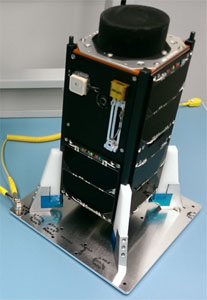AMSAT-UK and AMSAT-NL working with ISIS BV are delighted to announce that the FUNcube 435/145 MHz SSB/CW transponder, on the 2U CubeSat QB50p1 (EO79), has now been activated with a regular schedule.
Due to power budget constraints the transponder cannot be operational 24/7 and an orbit specific schedule has been developed. The transponder will commence operation 27 minutes after the spacecraft enters sunlight and will stay on for a period of 25 minutes. This schedule may be modified over the forthcoming weeks as a result of experience.
The transponder nominal frequencies are:
Uplink: 435.047-435.077 MHz LSB
Downlink: 145.935-145.965 MHz USB
The output power is approximately 400mW.
David Bowman G0MRF has been attempting to characterize the actual operating frequencies of the EO79 Transponder and suggests that the operational bandwidth of the transponder might be considered to be 25 kHz rather than 30 kHz. His report is available here. On the AMSAT Bulletin Board he writes:
From observations, there seems to be no downlink below 145.946 MHz. By taking readings at Time of Closest Approach (TCA) on low elevation passes, which for me is about 20 minutes into the 25 minute schedule. The transponder appears as follows:
Downlink.
Lower limit is quite well defined at 145.946.
Upper limit roles off slowly above 970. But 145.971 seems a reasonable limit. Very strong signals are visible to 973 but are heavily attenuated.
Uplink
Upper limit (for 145.946) = 435.0723
Lower limit (for 145.971) = 435.0473
This suggests the transponder has a nominal bandwidth of 25 kHz. My best guess at a translation frequency is 581.0183MHz
Qb50p1 (EO79) was launched in June 2014, as a collaborative effort led by the von Karman Institute and ISIS-BV, into a sun synchronous 620×600 km polar orbit as a precursor spacecraft for the QB50 mission. The primary function of the satellite was to test a number of the systems and science payloads. This phase has now been completed and we are grateful to VKI and ISIS BV for carrying this transponder into space and, again, to ISIS, for developing and uploading the new, required, flight code.
We hope you have lots of fun using EO79!


You must be logged in to post a comment.